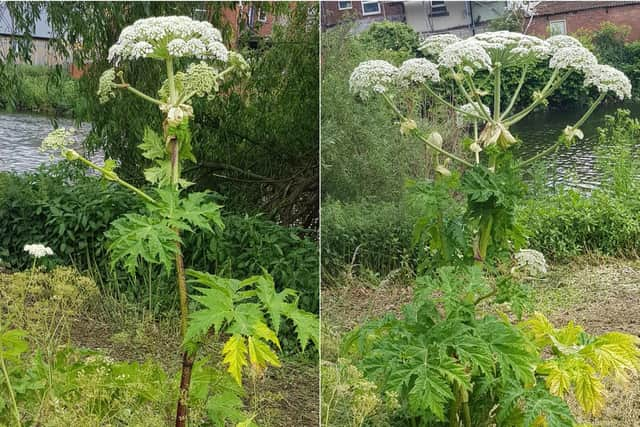Warning after 'UK's most dangerous plant' giant hogweed spotted in Castleford
and live on Freeview channel 276
Giant hogweed has been described as 'the most dangerous plant in Britain' by the Mersey Basin Rivers Trust.
The plant is growing near the Millenium Bridge - next to the river - in Castleford.
The sap of giant hogweed can cause burns.


Advertisement
Hide AdAdvertisement
Hide AdIt contains furocoumarin, which makes skin extremely sensitive to sunlight (phytophotodermatitis).
What is giant hogweed?
Giant hogweed (Heracleum mantegazzianum) is a plant in the Apiaceae family (previously known as the Umbelliferae).
This family includes some well-known plants such as parsley, carrot, parsnip, cumin and coriander.
Where does giant hogweed grow?
Giant hogweed is not native to the UK. It originates from the Caucasus Mountains and Central Asia.
Advertisement
Hide AdAdvertisement
Hide AdIt was first introduced to the UK as an ornamental in the 19th century where it escaped and naturalised in the wild.
It can now be found throughout much of the UK, especially colonising river banks where its seeds are transported by the water.
What does giant hogweed look like?
Giant hogweed looks like an enormous cow parsley.
When it's fully grown, it can reach towering heights of between 1.5m to 5m and have a spread of between 1 and 2m.
It forms a rosette of jagged, lobed leaves in the first year before sending up a flower spike in the second year and then setting seed.
Advertisement
Hide AdAdvertisement
Hide AdStems: green with purple blotches and stiff, white hairs. Stems are hollow with ridges and have a thick circle of hairs at base of each leaf stalk.
Leaves: huge, up to 1.5m wide and 3m long and is deeply divided into smaller leaflets. It looks a bit like a rhubarb leaf, with irregular and very sharp or jagged edges - which has given rise to one of its other common names - wild rhubarb.The underside of the leaf is hairy.
Flowers: appear in June and July. They are small and white (or slightly pink) and are clustered on umbrella-like heads known as umbels that can reach a diameter of 60cm. All the flowers on the umbel face upwards.
Seeds: dry, flattened, and oval. Almost 1cm long with tan with brown lines extending 3/4 of the seed length.
Is giant hogweed dangerous?
Advertisement
Hide AdAdvertisement
Hide AdIn short - the sap of giant hogweed can cause burns. It contains furocoumarin, which makes skin extremely sensitive to sunlight (phytophotodermatitis).
If the sap gets onto your skin, then you are exposed to sun, your skin can blister badly and blistering can recur over months and even years.
This is known as phytotoxicity.
The best way to avoid injury is to familiarise yourself with the plant.
Avoid brushing through patches of giant hogweed and exposing yourself to plants which have been cut which might cause you to get sap on your skin.
What happens if you touch giant hogweed?
If you do get giant hogweed sap on your skin, be sure to wash the area thoroughly immediately, seek medical advice, and do not expose the area to sunlight for a few days.
(Source: Woodland Trust)